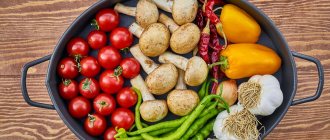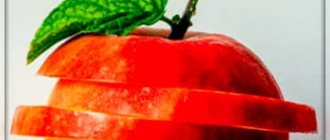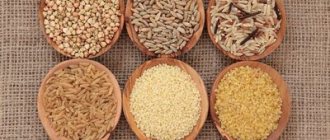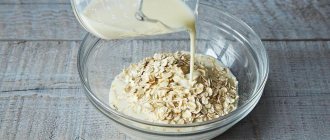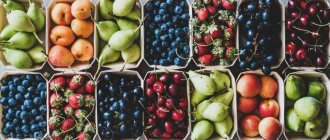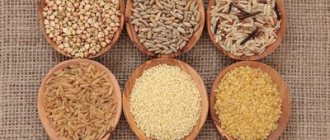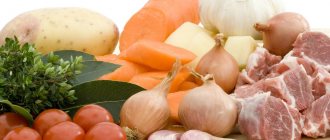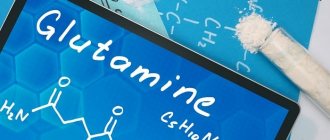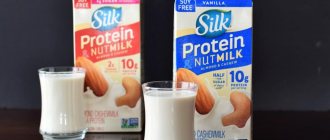Those who are going to lose weight first of all need to know what the glycemic index of food is and why it is needed. A common mistake of those losing weight is snacking at a late time on seemingly light foods, such as a banana or grapes. But this would not happen if everyone knew about the effect of these carbohydrates on blood glucose levels and fat deposition. Let's look at what GI is, why its level is so important when losing weight, and what foods you shouldn't eat at all.
What is the glycemic index and what does it affect?
The glycemic index is a measure of the effect of carbohydrates on increasing blood sugar levels. The higher the GI of the product, the stronger the jump in glucose and the surge of insulin. This indicator applies to products containing carbohydrates; protein products such as meat, seafood and eggs do not have this.
Understanding the GI level is necessary in order to establish nutrition for weight loss. This is especially important with elevated blood glucose levels, as well as with diabetes mellitus.
When simple carbohydrates with a high GI enter the body, the following happens: the blood sugar level rises sharply, and the hormone insulin is produced, which lowers this sugar. And, as you know, high glucose levels are a risk of developing diabetes.
If you constantly consume foods with a high GI, over time, glucose tolerance is impaired, insulin ceases to be produced to the required extent, and accordingly, blood sugar remains at a high level, and diabetes develops.
As for external negative manifestations, foods that sharply increase sugar are absorbed very quickly, unlike complex carbohydrates. Therefore, the faster the carbohydrates, the higher the risk of their deposition in the form of subcutaneous fat. And the slower they are, the greater the opportunity to expend energy from carbohydrates and not accumulate it in problem areas. This means that it is better to eat foods with a low glycemic index. Next, we will dwell in more detail on each level.
Fruits and berries
A fruit is a juicy fruit of a bush or tree suitable for consumption. These products are valuable for their rich composition (especially vitamin C), which is indispensable for daily consumption. In terms of energy ratio, most fruits have the following composition:
- proteins – about 10%;
- lipids – about 3-5%;
- carbohydrates – 85-90%.
High levels of carbohydrates do not prevent even people with diabetes from including foods in their diet, since there are a number of fruits that have low glycemic index values. Fiber and a rich vitamin and mineral composition will only be beneficial.
Berries are a storehouse of essential substances. Their beneficial properties are aimed at restoring the body’s immune defense, cleansing, and saturating cells and tissues with vitamins and microelements.
Fruits and berries have the following composition:
- beta-carotene;
- B-series vitamins;
- tocopherol;
- a nicotinic acid;
- trace elements (potassium, iron, manganese, calcium);
- essential amino acids;
- bioflavonoids.
The above substances are necessary to strengthen vascular walls and increase their elasticity, stabilize blood pressure, and normalize metabolism. They are able to protect the body from free radicals, improve blood supply, have an antitumor effect, and restore defenses.
Fruits and berries are irreplaceable products in the daily menu of a healthy person and a diabetic
Why GI is important for athletes
There are exercisers who need a high GI and those who need foods with a low GI. And these are two completely opposite categories of athletes pursuing different goals.
- For those who are gaining muscle mass, it is very important to consume not only proteins, but also foods with medium and even high GI. We have already figured out that high GI foods contribute to the production of the hormone insulin. And it, in turn, has a powerful anabolic effect. Therefore, in order to constantly maintain a high level of anabolism and prevent hypoglycemia, it is important for athletes to know which foods have the desired glycemic index.
- The second reason to eat foods according to the glycemic index is cutting, losing weight or eating right. The drying period or weight loss involves a maximum reduction in the level of subcutaneous fat, so at this time it is especially important to create an energy deficit from carbohydrates. And this deficiency is achieved by eating a minimum amount of low GI foods so as not to cause spikes in blood sugar.
Also, knowing the GI of foods, you can control your weight and maintain your metabolic rate. And this is necessary not only for athletes, but for everyone who cares about their own health.
Vegetables
Vegetables are a source of vitamins, microelements, and fiber. The combination of this type of product in the diet has a beneficial effect on the human body, normalizes the functioning of the gastrointestinal tract, and increases the likelihood of absorption of each vitamin included in the composition. Vegetables should be an obligatory part of the daily menu of not only a sick person, but also a healthy person.
The products contain virtually no lipids and have low levels of proteins and carbohydrates. In most cases - low-calorie. The main value of vegetables is that they have a significant amount of ascorbic acid, pectin, folic acid, carotene, and minerals. The daily requirement is at least 600 g.
The table shows the GI indicators and calorie content of the most popular vegetables.
GI and calorie data - the ability to add or exclude necessary products
How to increase your vegetable intake
Pros and cons of foods with a high glycemic index
Pros of high GI:
- Provides the production of the anabolic hormone insulin, which promotes muscle gain.
- Products with the maximum GI, especially sugar, sharply increase the level of glucose in the blood during hypoglycemia, loss of consciousness, and therefore serve as a means of “first aid”.
- Quickly increase energy in the body after consumption. With a sudden onset of weakness, such products can be said to put you on your feet, nourish the liver and brain.
Minuses:
- Excessive consumption of such foods over time leads to impaired glucose tolerance, deterioration in the production of insulin, which lowers blood sugar, which can cause diabetes.
- The rapid absorption of foods with a high GI provokes the deposition of fast carbohydrates in the form of subcutaneous fat. Therefore, uncontrolled consumption of simple carbohydrates leads to overweight and obesity.
- Foods with a high glycemic index fill you up for a short time, and hunger sets in much faster than with complex carbohydrates.
Fish and seafood
The importance of this group lies in its richness in beneficial Omega-3 fatty acids, which play a significant role in the preventive measures of cardiovascular diseases. In addition, fish and seafood contain:
- phosphorus and calcium - for normal functioning of the musculoskeletal system and good dental condition;
- copper – for the synthesis of blood cells, connective tissue elements and nerve fibers;
- iodine – for normal functioning of the thyroid gland;
- iron – for the formation of hemoglobin and transport of oxygen to the cells and tissues of the body;
- potassium - for the proper functioning of the muscular system, nervous tissue, normal blood pressure;
- magnesium – to normalize metabolism, proper functioning of the musculoskeletal system, DNA formation;
- zinc – for the possibility of conceiving a child, restoring the functioning of protective forces.
Seaweed has a GI index of 22, boiled crayfish - 5, fish cutlets - 50, crab sticks - 40. The rest of the products included in this group have an index of 0.
Table of foods with high GI - over 70
| The product's name | Glycemic index |
| Semolina | 70 |
| Couscous | 70 |
| Risotto | 70 |
| Chips | 70 |
| Pearl barley | 70 |
| Noodles | 70 |
| Croissant | 70 |
| Carbonated drinks | 70 |
| Chocolate bars | 70 |
| Milk chocolate | 70 |
| Millet | 71 |
| Waffles | 75 |
| Lasagna | 75 |
| Rice porrige | 75 |
| French baguette | 75 |
| Watermelon | 75 |
| Pumpkin | 75 |
| Donuts | 76 |
| Muesli with nuts | 80 |
| Crackers | 80 |
| Mashed potatoes | 83 |
| Rice pudding with milk | 85 |
| Popcorn | 85 |
| Cornflakes | 85 |
| Boiled carrots | 85 |
| White rice | 90 |
| White bread gluten free | 90 |
| Canned apricots | 91 |
| Rice noodles | 92 |
| Potato casserole | 95 |
| Fried potatoes | 95 |
| Baked potato | 95 |
| Butter buns | 95 |
| Swede | 99 |
| Starch | 100 |
| Glucose | 100 |
| White bread | 100 |
| Dates | 103 |
| Beer | 110 |
Beverages
Mineral water is one of the recommended drinks, which is used for daily consumption (table water) and as a component of therapeutic measures (medical table water, medicinal mineral water).
It should be remembered that carbonated mineral water should be avoided.
Juices are another storehouse of vitamins and microelements. Preference is given to freshly made drinks rather than store-bought ones, which contain a significant amount of dyes and preservatives. Experts found the juices of lemon, tomatoes, blueberries, potatoes and pomegranate to be the most useful. In order to add a slight sweetness, add a little honey or maple syrup.
Although coffee is considered a metabolic stimulant, it is better to discuss its use with your doctor or nutritionist. When it comes to tea, preference is given to green varieties, as well as self-made herbal teas based on raspberry and blueberry leaves.
It is better to exclude alcoholic drinks from the diet altogether. Sometimes it is allowed to drink dry red wine (no more than a glass), forty-degree drinks (no more than 70-100 ml). It is better to avoid liqueurs, champagne, and sweet alcoholic cocktails, especially for patients with diabetes.
Drinks are an important component of the daily diet, which also requires correction.
Pros and cons of foods with medium GI
Pros:
- Products with an average index are not digested as quickly as those with a high index. Such carbohydrates are broken down more slowly, which makes it possible to consume energy from them with less risk of accumulation of subcutaneous fat.
- They also help maintain muscle anabolism.
- They allow you to quickly replenish the lack of energy when hunger strikes.
- In terms of their usefulness and the presence of microelements, products with an average GI are richer than those with a high GI.
- If you want to indulge and eat something sweet, the best option would be products with an average rating rather than a high one.
Minuses:
- With excessive consumption of such products, there is also a risk of accumulation of subcutaneous fat, especially when consumed in the evening.
- They saturate for a short time and also contribute to a fairly rapid jump in glucose in the blood.
Meat and eggs
These products are a source of protein. The human body requires 20 amino acids to function properly, 9 of which must be regularly supplied from food. Chicken and beef meat are considered the most popular due to their lower fat content. Ham, bacon and other types of pork meat are high in lipids, so their consumption should be limited.
In preparation, you should use stewing, boiling, simmering, and steaming. Must be combined with fresh or stewed vegetables and cereals.
Meat and eggs are products belonging to the low and medium GI group
Table of foods with average GI - from 50 to 69
| Name | Glycemic index |
| Apple juice | 50 |
| Persimmon | 50 |
| Brown brown rice | 50 |
| Pineapple juice | 50 |
| Mango | 50 |
| Kiwi | 50 |
| Cranberry juice | 50 |
| Canned Peaches | 55 |
| Sushi | 55 |
| Bulgur | 55 |
| Spaghetti | 55 |
| Grape juice | 55 |
| Potato sweet potato | 55 |
| Canned corn | 57 |
| Papaya | 59 |
| Cocoa | 60 |
| Oatmeal | 60 |
| Melon | 60 |
| Lasagna | 60 |
| Rice | 60 |
| Banana | 60 |
| Sprouted wheat | 63 |
| Canned vegetables | 65 |
| Whole wheat bread | 65 |
| Sorbent | 65 |
| Jacket potatoes | 65 |
| Rye bread | 65 |
| Raisin | 65 |
| Canned pineapple | 65 |
| Muesli | 65 |
| Marmalade | 65 |
| Black bread | 65 |
| Boiled beets | 65 |
| Cereals | 66 |
| Wheat flour | 69 |
Fully or partially limited products
- Limit salt intake.
- Exclude jams, jams, sweet juices, cakes, sweet desserts, cakes, pastries, ice cream, products with cream, lemonades, cheese curds with sugar, sweet yoghurts.
- Semolina, refined flour pasta, white polished rice.
- Bananas, kiwi, grapes, pineapple, melons, watermelons.
- Boiled corn, beets and carrots, potatoes (fried and boiled).
- As with any diet, fatty foods and spicy foods that stimulate the appetite are excluded (fatty meats, sauces, sausages, smoked foods, fried foods, pickled vegetables, canned food, seasonings).
Table of prohibited products
| Proteins, g | Fats, g | Carbohydrates, g | Calories, kcal | |
Vegetables and greens | ||||
| boiled carrots | 0,8 | 0,3 | 5,0 | 25 |
| boiled beets | 1,8 | 0,0 | 10,8 | 49 |
| horseradish | 3,2 | 0,4 | 10,5 | 56 |
Fruits | ||||
| apricots | 0,9 | 0,1 | 10,8 | 41 |
| pineapples | 0,4 | 0,2 | 10,6 | 49 |
| watermelon | 0,6 | 0,1 | 5,8 | 25 |
| bananas | 1,5 | 0,2 | 21,8 | 95 |
| melon | 0,6 | 0,3 | 7,4 | 33 |
| mango | 0,5 | 0,3 | 11,5 | 67 |
| nectarine | 0,9 | 0,2 | 11,8 | 48 |
| peaches | 0,9 | 0,1 | 11,3 | 46 |
Berries | ||||
| grape | 0,6 | 0,2 | 16,8 | 65 |
Nuts and dried fruits | ||||
| raisin | 2,9 | 0,6 | 66,0 | 264 |
| dried figs | 3,1 | 0,8 | 57,9 | 257 |
| dates | 2,5 | 0,5 | 69,2 | 274 |
Cereals and porridges | ||||
| semolina | 10,3 | 1,0 | 73,3 | 328 |
| corn grits | 8,3 | 1,2 | 75,0 | 337 |
| pearl barley | 9,3 | 1,1 | 73,7 | 320 |
| millet cereal | 11,5 | 3,3 | 69,3 | 348 |
Flour and pasta | ||||
| pasta | 10,4 | 1,1 | 69,7 | 337 |
| noodles | 12,0 | 3,7 | 60,1 | 322 |
Bakery products | ||||
| wheat bread | 8,1 | 1,0 | 48,8 | 242 |
Confectionery | ||||
| jam | 0,3 | 0,2 | 63,0 | 263 |
| candies | 4,3 | 19,8 | 67,5 | 453 |
| pastry cream | 0,2 | 26,0 | 16,5 | 300 |
Ice cream | ||||
| ice cream | 3,7 | 6,9 | 22,1 | 189 |
Raw materials and seasonings | ||||
| mustard | 5,7 | 6,4 | 22,0 | 162 |
| mayonnaise | 2,4 | 67,0 | 3,9 | 627 |
| honey | 0,8 | 0,0 | 81,5 | 329 |
| sugar | 0,0 | 0,0 | 99,7 | 398 |
Dairy | ||||
| baked milk | 3,0 | 6,0 | 4,7 | 84 |
| cream | 2,8 | 20,0 | 3,7 | 205 |
| sour cream 25% (classic) | 2,6 | 25,0 | 2,5 | 248 |
| sour cream 30% | 2,4 | 30,0 | 3,1 | 294 |
| Ryazhenka 6% | 5,0 | 6,0 | 4,1 | 84 |
Cheeses and cottage cheese | ||||
| glazed cheese | 8,5 | 27,8 | 32,0 | 407 |
| curd | 7,1 | 23,0 | 27,5 | 341 |
Meat products | ||||
| pork | 16,0 | 21,6 | 0,0 | 259 |
| salo | 2,4 | 89,0 | 0,0 | 797 |
Bird | ||||
| smoked chicken | 27,5 | 8,2 | 0,0 | 184 |
| duck | 16,5 | 61,2 | 0,0 | 346 |
| smoked duck | 19,0 | 28,4 | 0,0 | 337 |
| goose | 16,1 | 33,3 | 0,0 | 364 |
Fish and seafood | ||||
| smoked fish | 26,8 | 9,9 | 0,0 | 196 |
| canned fish | 17,5 | 2,0 | 0,0 | 88 |
| sardine in oil | 24,1 | 13,9 | — | 221 |
| cod (liver in oil) | 4,2 | 65,7 | 1,2 | 613 |
Oils and fats | ||||
| animal fat | 0,0 | 99,7 | 0,0 | 897 |
| cooking fat | 0,0 | 99,7 | 0,0 | 897 |
Non-alcoholic drinks | ||||
| lemonade | 0,0 | 0,0 | 6,4 | 26 |
| Pepsi | 0,0 | 0,0 | 8,7 | 38 |
| Fanta | 0,0 | 0,0 | 11,7 | 48 |
Juices and compotes | ||||
| apricot juice | 0,9 | 0,1 | 9,0 | 38 |
| grape juice | 0,3 | 0,0 | 14,0 | 54 |
| pumpkin juice | 0,0 | 0,0 | 9,0 | 38 |
| * data is per 100 g of product | ||||
Table of foods with a low glycemic index - below 50
| Name | Glycemic index |
| Lettuce leaf | 9 |
| Avocado | 10 |
| Spinach | 15 |
| Soybeans | 15 |
| Tofu | 15 |
| Peanut | 15 |
| Olives | 15 |
| Zucchini | 15 |
| Mushrooms | 15 |
| Asparagus | 15 |
| Walnut | 15 |
| Cucumber | 15 |
| Cauliflower | 15 |
| Brussels sprouts | 15 |
| White cabbage | 15 |
| Broccoli | 15 |
| Spinach | 15 |
| Celery | 15 |
| Bran | 15 |
| Eggplant | 20 |
| Artichoke | 20 |
| Pumpkin seeds | 25 |
| Strawberry | 25 |
| Strawberries | 25 |
| Currant | 25 |
| Raspberries | 25 |
| Beans | 25 |
| Cherry | 25 |
| Green lentils | 25 |
| Mandarin | 30 |
| passion fruit | 30 |
| Milk | 30 |
| Lentils yellow | 30 |
| Blueberry | 30 |
| Cowberry | 30 |
| Dark chocolate from 70% cocoa | 30 |
| Cottage cheese | 30 |
| Tomato | 30 |
| Pear | 30 |
| Beet | 30 |
| Carrot | 30 |
| Grapefruit | 30 |
| Brown lentils | 30 |
| Apricot | 30 |
| Tomato juice | 33 |
| Peach | 34 |
| Pomegranate | 34 |
| Nectarine | 34 |
| Yogurt | 35 |
| Quince | 35 |
| Plum | 35 |
| Orange | 35 |
| Sesame | 35 |
| Green pea | 35 |
| Apple | 35 |
| Wild rice | 35 |
| Prunes | 40 |
| Dried apricots | 40 |
| Pasta | 40 |
| Buckwheat | 40 |
Authorized Products
- Vegetables: lettuce, different types of cabbage, eggplant, cucumbers, spinach, garlic, squash, lettuce, radish, mushrooms, turnips, raw carrots, radishes. Vegetables and herbs should be consumed up to 500-600 g daily. It is better to eat them raw to preserve vitamins. Add sesame seeds, nuts and vegetable oil to salads. Stewing vegetables is allowed. Seaweed, a source of iodine, vitamins and fiber, can be an addition to any dish.
- Rye bread, whole grain gray bread and crispbread, rice bran crispbread. You can eat 1-2 pieces per day in the morning.
- Unsweetened fresh berries and fruits. Among fruits, you should prefer citrus fruits, cherries, cranberries, plums, strawberries, lingonberries, apples, gooseberries, raspberries, pears, strawberries, avocados.
- Cereals should be limited if you want to lose weight. But whole grain porridge (buckwheat, not crushed oatmeal), wild brown rice can be present in the diet once a day.
- Legumes are sources of protein and fiber and also contain no fat. They can be used several times a week. Legumes are regarded as a protein dish and are combined with various vegetables.
- Zero GI: meat, fish, poultry, eggs, since they do not contain carbohydrates. These products should be present in the diet at any stage. Choose lean meat and chicken, having skinned it. It is useful to boil or bake them without adding fat.
- Low-fat fish of dietary varieties (pollock, pike perch, blue whiting, hake, cod, pike, carp, navaga). Fish protein is easier to digest, fish is rich in phosphorus, iodine, magnesium and should be included in the diet more often than meat. Cooking method: boiling, baking, steaming.
- The first courses are prepared in vegetable broth or weak meat broth. Soups should be prepared mainly from vegetables or mushrooms.
- The diet contains low-fat fermented milk products and half-fat cottage cheese and cheese. They can be consumed in their natural form or as part of dishes.
- Various vegetable oils in salads. Pine nut and walnut oils are useful and can be used in carrot salads. Pumpkin, sea buckthorn, sesame, flaxseed and olive have the ratio of omega-3 and omega-6 acids .
- Nuts - in moderation, given their high calorie content. Nuts with any fruit can serve as a snack.
- Soft-boiled eggs or omelet with vegetables.
- Coffee with milk without sugar, green tea, rosehip infusion, unsweetened herbal teas, juices from permitted vegetables and fruits.
Table of permitted products
| Proteins, g | Fats, g | Carbohydrates, g | Calories, kcal | |
Vegetables and greens | ||||
| zucchini | 0,6 | 0,3 | 4,6 | 24 |
| sauerkraut | 1,8 | 0,1 | 4,4 | 19 |
| cauliflower | 2,5 | 0,3 | 5,4 | 30 |
| cucumbers | 0,8 | 0,1 | 2,8 | 15 |
| radish | 1,2 | 0,1 | 3,4 | 19 |
| tomatoes | 0,6 | 0,2 | 4,2 | 20 |
| pumpkin | 1,3 | 0,3 | 7,7 | 28 |
Fruits | ||||
| cherry | 0,8 | 0,5 | 11,3 | 52 |
| pears | 0,4 | 0,3 | 10,9 | 42 |
| plums | 0,8 | 0,3 | 9,6 | 42 |
| apples | 0,4 | 0,4 | 9,8 | 47 |
Berries | ||||
| cowberry | 0,7 | 0,5 | 9,6 | 43 |
| blackberry | 2,0 | 0,0 | 6,4 | 31 |
| raspberries | 0,8 | 0,5 | 8,3 | 46 |
| currant | 1,0 | 0,4 | 7,5 | 43 |
Cereals and porridges | ||||
| buckwheat (kernel) | 12,6 | 3,3 | 62,1 | 313 |
| oat groats | 12,3 | 6,1 | 59,5 | 342 |
| boiled wild rice | 4,0 | 0,3 | 21,1 | 100 |
| barley grits | 10,4 | 1,3 | 66,3 | 324 |
Bakery products | ||||
| Rye bread | 6,6 | 1,2 | 34,2 | 165 |
| bran bread | 7,5 | 1,3 | 45,2 | 227 |
| whole grain bread | 10,1 | 2,3 | 57,1 | 295 |
Dairy | ||||
| milk | 3,2 | 3,6 | 4,8 | 64 |
| kefir | 3,4 | 2,0 | 4,7 | 51 |
| sour cream 15% (low fat) | 2,6 | 15,0 | 3,0 | 158 |
| curdled milk | 2,9 | 2,5 | 4,1 | 53 |
| yogurt | 4,3 | 2,0 | 6,2 | 60 |
Cheeses and cottage cheese | ||||
| cottage cheese 0.3% | 18,0 | 0,3 | 3,3 | 90 |
Meat products | ||||
| beef | 18,9 | 19,4 | 0,0 | 187 |
| beef tongue | 13,6 | 12,1 | 0,0 | 163 |
| veal | 19,7 | 1,2 | 0,0 | 90 |
| rabbit | 21,0 | 8,0 | 0,0 | 156 |
Bird | ||||
| chicken | 16,0 | 14,0 | 0,0 | 190 |
| turkey | 19,2 | 0,7 | 0,0 | 84 |
Eggs | ||||
| chicken eggs | 12,7 | 10,9 | 0,7 | 157 |
Oils and fats | ||||
| butter | 0,5 | 82,5 | 0,8 | 748 |
| corn oil | 0,0 | 99,9 | 0,0 | 899 |
| olive oil | 0,0 | 99,8 | 0,0 | 898 |
| sunflower oil | 0,0 | 99,9 | 0,0 | 899 |
Non-alcoholic drinks | ||||
| mineral water | 0,0 | 0,0 | 0,0 | — |
| coffee | 0,2 | 0,0 | 0,3 | 2 |
| instant chicory | 0,1 | 0,0 | 2,8 | 11 |
| black tea without sugar | 0,1 | 0,0 | 0,0 | — |
Juices and compotes | ||||
| plum juice | 0,8 | 0,0 | 9,6 | 39 |
| tomato juice | 1,1 | 0,2 | 3,8 | 21 |
| rose hip juice | 0,1 | 0,0 | 17,6 | 70 |
| Apple juice | 0,4 | 0,4 | 9,8 | 42 |
| * data is per 100 g of product | ||||
The influence of GI foods on weight loss
Having studied all the pros and cons of different GI levels, we can say that to lose weight it is necessary to consume exclusively foods with a low glycemic index. Carbohydrates of this level do not cause a sharp increase in blood glucose; they are released more slowly, which makes it possible to spend this energy rather than accumulate it.
But remember , heat treatment increases the GI level, so it is better to eat vegetables and fruits unprocessed, and soak cereals in water overnight rather than cook them.
Also, despite the low GI level, carbohydrates are still undesirable for consumption in the evening. It is better to eat them before 16.00; at a later time, only vegetables with a minimum indicator are allowed.
What does GI depend on?
As you know, the dishes that a person eats consist of several products, each of which has its own glycemic index. Interestingly, with heat treatment this indicator increases significantly. For example, the glycemic index of raw carrots is 35, and the GI of a cooked vegetable increases by 50 units, reaching 85.
Thus, changes in the glycemic index can be affected by the following:
- adding flavorings or sugar;
- the amount of fiber contained in the product - the more fiber the product contains, the lower its glycemic index (fiber slows down the digestive process and prevents the rapid entry of glucose into the blood);
- processing method – after thermal and mechanical processing of the product, its glycemic index increases when the food requires more thorough chewing, as a rule, it has a low GI;
- degree of ripeness - in this case we are talking about vegetables, berries and fruits, the riper they are, the higher their glycemic index, the table shows average values;
- ingredients used for cooking - whole grain bread has a lower glycemic index than fluffy wheat bread;
- degree of grinding - the better the ingredients are crushed during the cooking process, the higher the glycemic index becomes (as an example, you can compare the GI value of a peach and its juice; it is lower for a whole fruit).
In addition, the individual characteristics of the body should be taken into account, since each person may have a different reaction to the use of the same product. It directly depends on the following factors:
- ecology of the place of residence;
- age;
- metabolism;
- immunity status;
- the presence of diseases of an infectious nature, accompanied by an inflammatory process or occurring without it;
- taking medications that affect the rate of protein breakdown;
- level of physical activity.
Thus, we can conclude that the glycemic index is a variable value, depending on many factors. However, knowing its average indicators, you can create your own diet so that it is as healthy as possible.
Nutritional Index
{banner_banstat9}
Fresh green vegetables have the highest CPI: lettuce, Brussels sprouts and fork sprouts. They are followed by firm green vegetables that can be used either fresh or frozen (asparagus, broccoli, artichoke, celery, cucumbers, zucchini).
Non-green vegetables, legumes and fresh fruits have approximately the same CPI (about 50). The position of 35 units is occupied by vegetables that contain starch (potatoes, rutabaga, pumpkin, carrots, parsnips). The next place was given to cereals and various types of nuts (22 and 20). The following products have a CPI of 15 and below:
- fish;
- dairy products;
- meat;
- eggs;
- cheeses;
- processed cereals, wheat baked goods;
- butter, margarine;
- all kinds of sweets.
Sample menu for a healthy diet and diabetes
- Breakfast: boiled fish, cabbage and apple salad, slice of bread, unsweetened tea.
- Snack: tea without sugar, vegetable puree.
- Lunch: vegetable soup, a piece of boiled beef, bread, an apple, a glass of still mineral water.
- Snack: cheesecakes, compote.
- Dinner: boiled egg, meat cutlets with cabbage, bread, tea.
- Snack: a glass of kefir.
It is important to remember that completely limiting yourself in food is strictly prohibited. The body of both a healthy and sick person must receive all the necessary vitamins, microelements, and organic substances for proper functioning and rapid recovery.
How is glucose absorbed?
The breakdown of complex sugars to glucose (pictured) occurs due to the food enzyme amylase.
Most foods, along with proteins and fats, contain carbohydrates, which are of two types:
- Simple carbohydrates or regular sugar are a water-soluble compound of glucose and fructose.
- Complex polysaccharides or starches are quite insidious and “not always sweet” substances.
The absorption of simple carbohydrates does not require additional enzyme participation. They quickly and independently break down into their components, but in order for starches to enter the bloodstream through the intestinal walls, they must be converted into glucose.
